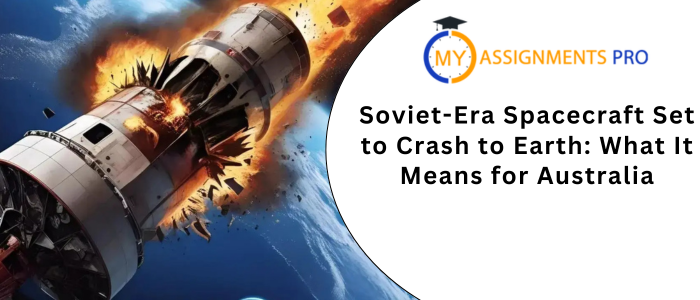
Space enthusiasts and scientists are bracing for a potentially spectacular but unpredictable event this weekend – the re-entry of part of a Soviet-era spacecraft, Kosmos 482, which is expected to crash back to Earth. Originally launched in 1972, this defunct piece of space history may soon plunge through our atmosphere, with experts still unsure exactly where it will land. Given Australia’s vast landmass, the question on many locals’ minds is whether it could end up down under.
The Origins of Kosmos 482
Kosmos 482 was launched on 31 March 1972, just days after the successful Venera 8 probe, as part of the Soviet Union’s ambitious attempt to explore Venus. Like its sister probe, Kosmos 482 was intended to study the Venusian atmosphere and surface, a mission requiring extraordinary engineering given the planet’s extreme heat, crushing pressure, and acidic atmosphere. However, while Venera 8 made it to Venus, Kosmos 482 never managed to escape Earth’s gravitational grip, getting trapped in a low Earth orbit and eventually breaking into several pieces.
Built for Extremes: Why Kosmos 482 Could Survive Re-entry
Most satellites and space debris burn up upon re-entering Earth’s atmosphere, but Kosmos 482 is no ordinary spacecraft. It was designed to withstand the punishing conditions of Venus, meaning its protective shielding and toughened structure make it far more likely to survive the fiery descent through our atmosphere.
Professor Marek Ziebart, a space geodesy expert at University College London, has noted that the lander probe – weighing around 500 kilograms and about a metre in diameter – is likely to survive re-entry. “Anything we try to send to Venus has to be armour-plated,” Ziebart explained. This level of durability, intended to endure the crushing pressures and searing heat of Venus, also makes it more resilient against the intense friction and heat of Earth’s atmospheric layers.
When and Where Will It Crash?
NASA estimates that Kosmos 482 could re-enter Earth’s atmosphere between 9 and 10 May, but the exact timing remains uncertain. Predicting the precise location of its crash is even trickier. The probe’s possible landing zone spans a wide band of latitudes between 52 degrees north and 52 degrees south, which includes parts of Europe, the Americas, Africa, Australia, and much of the world’s oceans. This means that, theoretically, it could crash anywhere from Sydney to Santiago or from Cape Town to California.
While experts can track the descending spacecraft using radar and telescopes, the vast area involved and the uncontrolled nature of the descent mean there will likely be significant uncertainty until the final moments before it re-enters. Ziebart noted that tracking efforts depend heavily on radar coverage, which is patchy in some parts of the world.
Could It Hit Australia?
While the risk remains low, it is not zero. Australia, with its extensive coastline and vast uninhabited interior, falls within the potential impact zone. Given that water covers roughly 72% of the Earth’s surface, the most probable outcome is that the probe will splash down in one of the world’s oceans. However, if it were to hit land, it could cause localized damage due to its mass and the high speed at which it will be travelling when it re-enters.
Past Incidents and Lessons Learned
This is not the first time fragments of Kosmos 482 have returned to Earth. Shortly after its launch, some components of the spacecraft landed in New Zealand, highlighting the unpredictable nature of uncontrolled re-entries. These incidents have prompted renewed discussions about the risks posed by space debris, as the increasing amount of abandoned satellites and spent rocket stages in orbit raises the stakes for future space missions and Earth-bound safety.
What’s Next for Space Junk?
The potential crash of Kosmos 482 is a stark reminder of the growing issue of space junk. Experts are calling for stricter international regulations to manage the debris orbiting our planet, including active debris removal strategies and the careful planning of satellite decommissioning to reduce the risk of uncontrolled re-entries.
For now, the world watches and waits as Kosmos 482 makes its final approach, a half-tonne reminder of the early days of space exploration and the ongoing challenge of keeping the heavens clear.
Conclusion: Keep Watching the Skies
As Kosmos 482 hurtles toward its uncertain final resting place, Australians and others within the potential impact zone can only wait and watch. While the odds are that the probe will end up in the ocean, the event is a reminder of the risks – and the enduring fascination – of humanity’s push into the final frontier.
Trusted Assignment Help – Fast, Affordable, and Stress-Free
Feeling overwhelmed by tight deadlines and a mountain of assignments? Our professional assignment help service is here to lighten the load. Whether it’s business, law, nursing, finance, or any other subject, we deliver 100% original, thoroughly researched work tailored to your university’s exact requirements. Enjoy fast turnaround times, exceptional quality, complete confidentiality, and student-friendly pricing. Plus, take advantage of our special discounts on bulk orders for even greater savings. Get in touch today for reliable assignment help that lets you focus on what really matters.
Source
Mitchell
Mitchell is a seasoned Ph.D. scholar with extensive expertise gained through years of rigorous research, publication, and teaching experience. He brings a wealth of knowledge and analytical skills to tackle complex academic challenges. His work is dedicated to delivering innovative solutions, advancing knowledge, and promoting academic excellence. Proficient in research methodology, data analysis, and scholarly writing, Mitchell has contributed to peer-reviewed journals and mentored students to achieve academic success.


